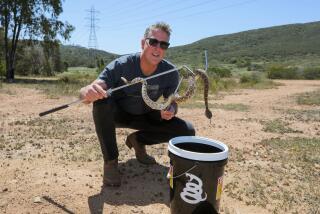Bill Haast dies at 100; snakes were the charm for south Florida celebrity
- Share via
If snake venom holds the secret to a long life, then Bill Haast had the magic.
The man who mesmerized generations of paying customers from 1947 to 1984 by extracting venom at his spine-tingling Miami Serpentarium attraction died of natural causes Wednesday at his home in Punta Gorda, on Florida’s west coast. He was 100.
Born William E. Haast on Dec. 30, 1910, in Paterson, N.J., he became a south Florida celebrity for surviving successive venomous snakebites. His wife, Nancy, last week put his lifetime tally at 172. The legacy left him immunized, she said, enabling him to donate life-saving blood to 21 victims through the years.
All survived, she said.
Grainy black-and-white television footage from 1962 shows a fit, toothy 51-year-old Haast in a hospital recovering from his 79th snakebite — his first ever by a king cobra.
A rare survivor, he declared himself doing “very well, anxious to get back to work.”
Why?
“I must.”
Haast’s death was a reminder of a bygone era when entrepreneurs could set up quirky roadside attractions along Dixie Highway, U.S. 1, to thrill both Florida schoolchildren and wintering vacationers fleeing the cold.
Part scientist, part entertainer, Haast spent his early years in Miami as a mechanic for Pan Am while he built the snake farm he called the Serpentarium along a portion of U.S. 1 that is today called Pinecrest, Fla. By the mid-1960s, he was putting on five shows a day, dressed in a white lab coat, extracting venom to sell for scientific experimentation.
“He was into it for the science on how snake venom affected the body,” said Michelle Haast, a grandniece who worked at the Serpentarium as a teen in the 1980s. He had done research for a polio vaccine and sought a cure for multiple sclerosis.
“He’d put on a show just to supplement the research,” she said. “And in the end, the research could take care of itself.”
The attraction had a gift shop, 400-pound turtles, a 20-foot python. It also had a pit with a 12-foot crocodile called Cookie who weighed, literally, a ton. After a 6-year-old boy fell in and died in 1977, Haast went into the pit with a pistol the next day and shot the croc.
He closed the business in 1984 and moved to Utah for a few years but returned to Florida in 1990, settling in a Punta Gorda ranch with Nancy, his third wife, and about 400 snakes that supplied his Miami Serpentarium Laboratories.
By his 95th birthday, he was still extolling the virtues of venom, saying he injected himself weekly with a cocktail from five snakes — cobras, cottonmouths, kraits, mambas and rattlers —homeopathy the Food and Drug Administration would never endorse.
“I could become a poster boy for the benefits of venom,” Haast boasted to a Miami Herald reporter. “If I live to be 100, I’ll really make the point.”
And so he did.
Besides his wife, he is survived by two daughters, two great-grandchildren and two great-great-grandchildren. A son, William Haast Jr., predeceased him.
Rosenberg writes for the Miami Herald and McClatchy Newspapers.
More to Read
Start your day right
Sign up for Essential California for the L.A. Times biggest news, features and recommendations in your inbox six days a week.
You may occasionally receive promotional content from the Los Angeles Times.




















































